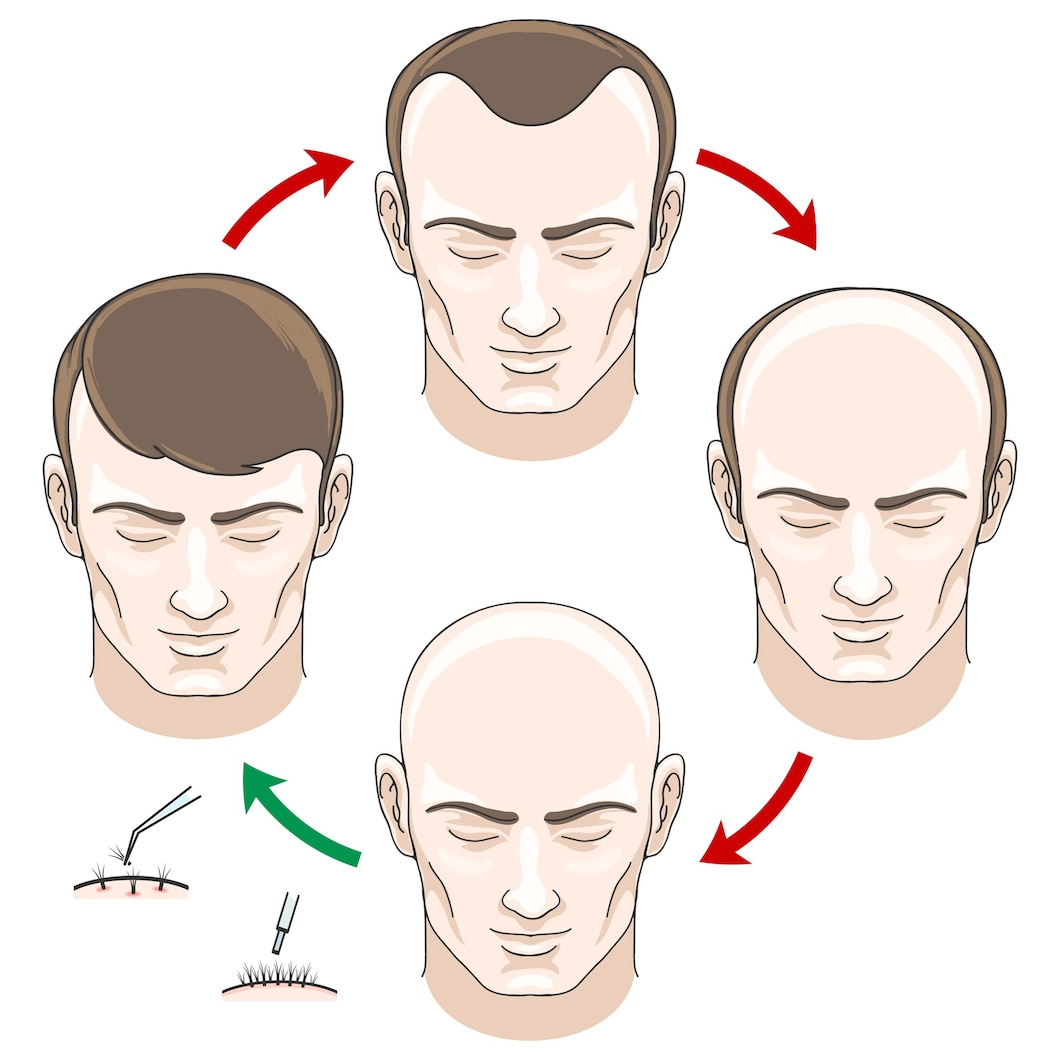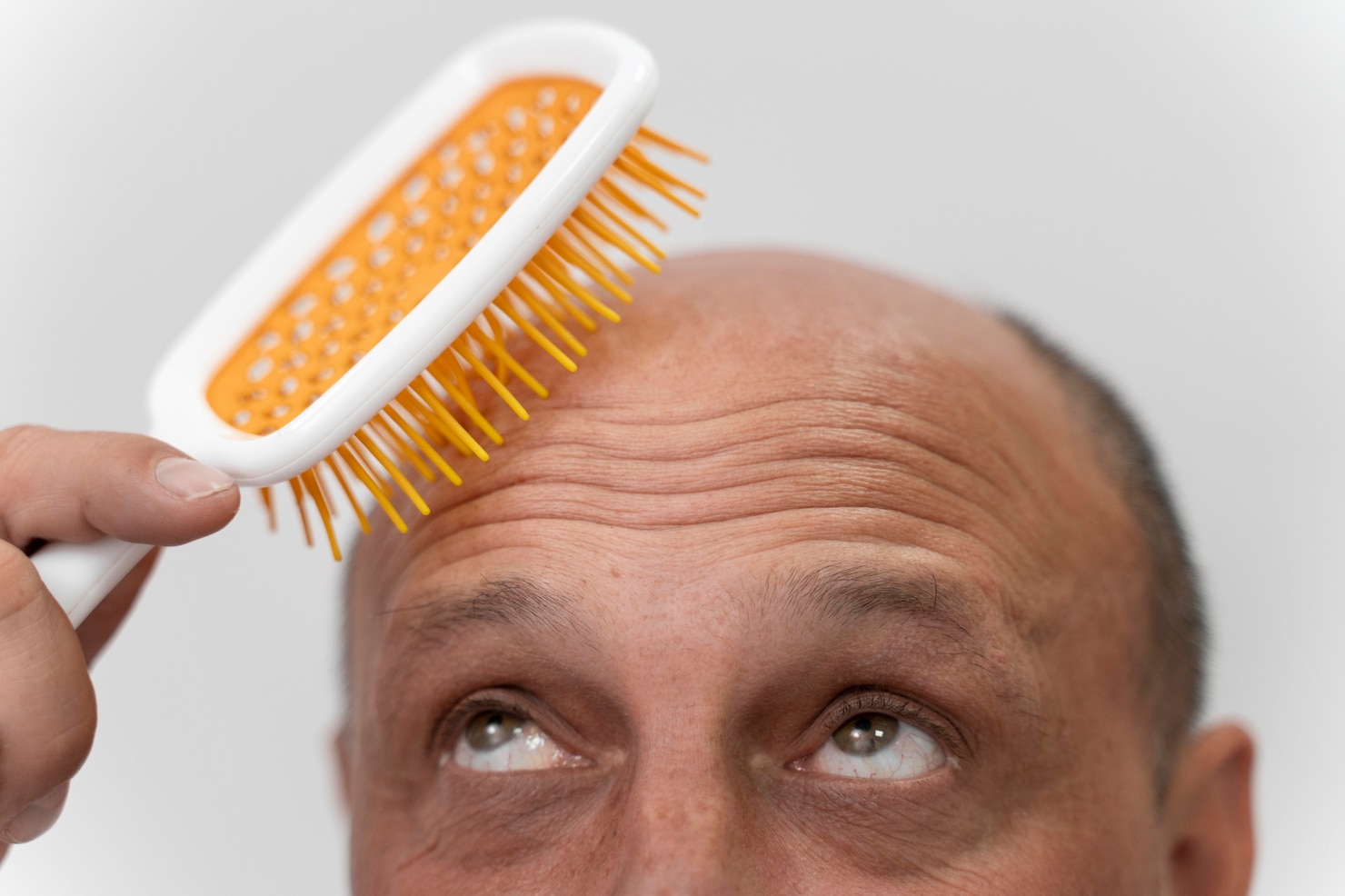
A receding hairline is a common concern among men, and understanding the different receding hairline stages is crucial for effective management. In this insightful blog, we will take you on a journey, mapping out the progression of a receding hairline from its initial onset to more advanced stages.
By exploring the causes, characteristics, and available treatments at each stage, you'll gain valuable knowledge to address this issue with confidence. And at the end of the blog, you won’t have to endlessly search for terms like “stages of receding hairline,” “stages receding hairline,” or “receding hairline early stages” anymore. Join us as we navigate the intricate terrain of receding hairlines, providing you with a comprehensive understanding of this common phenomenon.
Introduction to Receding Hairline Stages
A receding hairline is a gradual and common phenomenon experienced by many men. It refers to the progressive thinning of hair along the temples and forehead, resulting in a higher, more prominent hairline. Understanding the stages of a receding hairline is crucial in managing and addressing this aesthetic concern effectively.
What is a receding hairline?
A receding hairline is characterized by the gradual retreat of the hairline, typically starting at the temples. It can manifest differently for each individual, with some experiencing a slight recession while others may have a more pronounced and advanced stage. The hair follicles in the affected areas become progressively weaker, leading to thinner, finer hair and, in some cases, hair loss.
Importance of understanding the stages of receding hairline.
Knowing the stages of a receding hairline is essential for several reasons. Firstly, it helps you accurately identify and monitor the progression of your hairline, allowing for timely intervention and treatment. Secondly, understanding the stages can provide insights into the underlying causes, such as genetics, hormonal imbalances, or lifestyle factors, enabling you to address these factors effectively. Lastly, it allows you to explore appropriate treatment options based on the stage of your hairline recession, ensuring you choose the most suitable and targeted solutions.
Key Takeaway:
Understanding the stages of a receding hairline is vital for effectively managing this aesthetic concern. By recognizing the signs and comprehending the underlying causes, you can take proactive steps to address them and explore appropriate treatment options tailored to your specific stage of hairline recession.Stage 1: Minimal Recession

Image Source: FreePik
In the early stages of receding hairline, known as Stage 1, there are distinct characteristics that indicate the initial signs of hairline recession. Understanding these features and the underlying causes can help you address the issue effectively.
Characteristics of Stage 1 receding hairline.
During Stage 1, you may notice a subtle and slight change in your hairline. The hair along the temples starts to recede slightly, creating a minimal V-shaped pattern. It is important to pay attention to these early indications, as they can serve as valuable warning signs for potential future progression. At this stage, you may experience minimal hair loss, and the recession might not be prominent enough to cause significant concern. However, being proactive and taking steps to prevent further recession is crucial to maintaining a healthy hairline.
Causes and factors contributing to Stage 1 recession.
Stage 1 receding hairline can be attributed to a combination of genetic and hormonal factors. Male pattern baldness, also known as androgenetic alopecia, is the most common cause of hairline recession in men. It is often inherited and can be influenced by the presence of dihydrotestosterone (DHT), a hormone derived from testosterone. Additionally, lifestyle factors such as stress, poor nutrition, and certain medical conditions may contribute to the onset of Stage 1 recession.
Key Takeaway:
Stage 1 of receding hairline is characterized by subtle changes in the hairline, with minimal recession along the temples. Understanding the characteristics and causes of this initial stage is crucial for early intervention and prevention of further recession. By being proactive and addressing the underlying genetic and hormonal factors, you can take control of your hair health and potentially slow down the progression of receding hairline.Stage 2: Mild Recession

Image Source: FreePik
As your receding hairline progresses to Stage 2, there are specific signs and factors that come into play. Identifying these indicators and understanding the factors that can accelerate the progression will empower you to take appropriate measures for managing this stage effectively.
Identifying Stage 2 receding hairline.
In Stage 2, the recession of your hairline becomes more noticeable. The V-shaped pattern becomes more pronounced, extending further back from the temples. You may also experience a slight thinning of hair in the affected areas. It is important to pay attention to these changes and monitor the progression to determine the appropriate steps to take.
Factors that may accelerate progression to Stage 2.
Several factors can contribute to the acceleration of hairline recession from Stage 1 to Stage 2. Genetic predisposition, especially if male pattern baldness runs in your family, plays a significant role. Hormonal imbalances, specifically the presence of dihydrotestosterone (DHT), can also influence the progression.
Additionally, certain lifestyle factors such as excessive stress, smoking, and poor nutrition may contribute to the advancement of the receding hairline. Understanding these factors allows you to make informed decisions about your hair care routine and overall lifestyle choices.
Key Takeaway:
Stage 2 of a receding hairline is characterized by a more noticeable recession of the hairline, forming a pronounced V-shape. Recognizing the signs of this stage and identifying the factors that can accelerate the progression is crucial for effective management. By addressing genetic predisposition, and hormonal imbalances, and adopting a healthy lifestyle, you can potentially slow down the advancement of your receding hairline and take control of your hair health.Stage 3: Moderate Recession
As you progress to Stage 3 of receding hairline, certain features become more apparent, and the impact on your self-esteem may become more pronounced. Understanding these features and recognizing the potential causes can help you navigate this stage with confidence and make informed decisions about your hair care routine.
In Stage 3, the recession of your hairline becomes more significant, forming a distinct M-shaped pattern. The hairline recedes further back from the temples, creating a noticeable gap in the middle. The hair density in the affected areas continues to decrease, leading to more visible scalp exposure. These features can be unsettling, as they alter your appearance and may require adjustments to your hairstyle or grooming routine.
Key Takeaway:
Stage 3 of a receding hairline is characterized by a prominent M-shaped pattern and increased scalp exposure in the middle of the hairline. Understanding the features of this stage and recognizing the potential causes can help you navigate the emotional impact on your self-esteem.Stage 4: Severe Recession
When you reach Stage 4 of receding hairline, the signs become more pronounced and may have a significant impact on your psychological well-being. Recognizing these signs and understanding the available treatments can help you address the challenges associated with severe hairline recession.
Recognizing the signs of Stage 4 receding hairline.
At Stage 4, the hairline recedes significantly, leaving a considerable gap between the remaining hair and the forehead. The M-shaped pattern becomes more prominent, and the temporal areas may experience extensive thinning or complete hair loss. The scalp becomes more visible, and the hair density continues to diminish. These signs can be distressing and may affect your overall appearance and self-image.
Key Takeaway
: Stage 4 of a receding hairline is characterized by a significant recession, with a notable gap between the remaining hair and the forehead. Recognizing these signs is crucial in addressing the psychological effects they may have on your well-being.Stage 5: Advanced Recession
As you enter Stage 5 of receding hairline, the characteristics become more pronounced, and finding effective hair restoration options becomes increasingly important. Understanding the specific characteristics of Stage 5 and exploring the available treatment options can help you navigate this advanced stage of hairline recession.
Understanding the characteristics of Stage 5 receding hairline.
At Stage 5, the hairline recedes further, resulting in a significant balding pattern. The temporal areas and the crown region experience extensive hair loss, leaving a notable amount of visible scalp. The remaining hair is often limited to the back and sides of the head. This advanced recession can significantly impact your appearance and self-confidence, necessitating a proactive approach to address it.
Hair restoration options for Stage 5

Image Source: FreePik
When it comes to restoring hair at Stage 5, hair transplantation is often considered a viable option. This surgical procedure involves transplanting healthy hair follicles from the donor area to the balding regions, effectively restoring hair growth.
Additionally, non-surgical solutions such as scalp micro pigmentation and the use of hair systems or wigs can provide effective coverage and enhance your overall appearance.
Key Takeaway:
Stage 5 of receding hairline signifies advanced recession with extensive hair loss in the temporal areas and crown region. Understanding the characteristics of this stage is crucial for exploring appropriate hair restoration options. Hair transplantation, scalp micro pigmentation, and the use of hair systems or wigs are potential solutions to consider.Conclusion
Understanding the stages of receding hairline is essential for anyone experiencing hair loss. By identifying the specific characteristics of each stage, you can better comprehend the progression of your receding hairline and make informed decisions about treatment options. From the initial signs of minimal recession to the advanced stages of severe and advanced recession, there are various solutions available to address the issue and restore your hairline.
Remember, early intervention is key. The sooner you recognize the signs and take action, the more effective the treatments can be.

